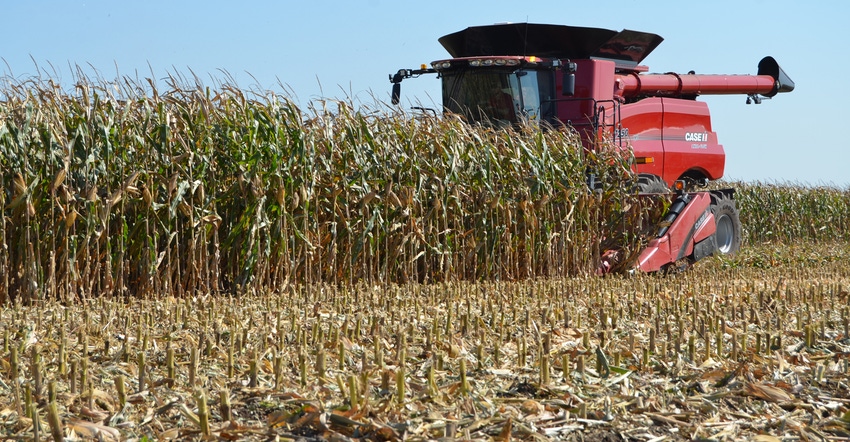August 15, 2019

By Kent Shannon
Adjusted properly, a combine can handle corn between 20% and 30% moisture. However, as moistures exceed 30%, work may be needed to a find balance between leaving unthreshed grain in the field and grain damage.
The following tips will help serve as a guide with the variability in this year's harvest season.
Ground speed. The first consideration when it comes to harvesting wet corn is ground speed. Be sure to select a ground speed that does not overload the machine, as the engine must be able to maintain its rated engine speed to keep separator and cleaning shoe at full speed. Adjust your hydrostatic transmission to maintain the engine near rated speed under varying crop conditions.
Header placement. The usual advice for minimizing trash input into the combine by operating the header as high as possible is even more critical in these wet conditions. Introducing tough, wet leaf and stalk material into the combine reduces its effectiveness to thresh and separate the grain. Wet stalks and leaves absorb threshing energy that normally would be used to separate grain from cobs. Additionally, this wet mat of material can overwhelm the separator, trapping both threshed and unthreshed grain. Consequently, consider operating the stripper (deck) plates wider to minimize leaf and stalk material entering the combine. However, be careful to avoid shelling the butt end of the ear with the stripper plates too wide.
Concave leveling. Before changing concave clearance, first make sure it is level side-to-side (conventional combine) or front-to-back (rotary combine) so that the adjustment is uniform. The operator's manual will provide details for this process, but it normally involves adjusting the right and left or fore and aft sides of the concave to ensure they are uniformly spaced from the cylinder or rotor. This will ensure that in-cab adjustments are accurate across the width or length of the concave. A poorly leveled concave could damage grain on the high side while underthreshing grain on the low side. Consequently, it would be impossible to balance between grain loss and damage. The operator's manual will give starting clearances for the combine, but generally set the concave approximately to the diameter of a shelled cob. A properly adjusted concave will break up some cob, but excessive broken cob is an indicator that the concave is set too close to the cylinder or rotor. Too many broken cobs can lead to high levels of cob in the clean grain tank or can overwhelm the cleaning shoe.
Cylinder or rotor speed. After the concave is adjusted properly, adjust the cylinder or rotor speed to maximize threshing in wet grain, but make sure this adjustment is balanced with grain damage. If grain damage becomes excessive, slow the cylinder or rotor. Do not increase the concave clearance. Concave spacing has very little effect on grain damage in corn.
Cleaning shoe. Always begin harvesting with the chaffer and sieve openings to the maximum specification in the operator's manual. Closing down the sieve will produce clean corn in the grain tank, but it also will increase tailings returned for rethreshing, which can increase grain damage. If there is too much cob in the grain tank, first try increasing airflow, then close the top chaffer sieve a little and finally the lower shoe sieve a little. Wet crop residue will require higher air speed compared with a dry crop.
Repair or replace. As with any harvest conditions, a poorly maintained combine will lead to higher grain losses and increased grain damage. Typically, one will need to increase cylinder or rotor speed to compensate for worn parts. On a conventional combine, check the concave for wear and look for rounded edges on the crossbars. On a rotary combine, check the threshing elements for worn and rounded edges. Replace concaves and rasp bars if wear exceeds the tolerances stated by the manufacturer. Please consult the operator's manual or local dealer for allowable wear tolerances.
If using chromed rasp bars to take advantage of its wear properties, one may consider switching back to a hardened rasp bars as the "ever-sharp" edges of the chromed rasp bar may be too aggressive on the potential of this season's soft kernel.
Depending on your machine, there may be additional parts to improve threshing performance in wet crops. For example, some manufacturers recommend rear concave inserts to improve threshing, while others offer round bar concaves and separating grates to prevent crop hair pinning.
Consult the operator's manual or your local dealer to determine what options are available for your combine.
Shannon is a University of Missouri Extension natural resource engineer.
You May Also Like




